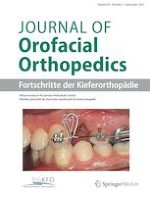Erschienen in:

29.06.2021 | Original Article
Dynamic force decay evaluation of latex and non-latex orthodontic elastics
verfasst von:
Robert Klabunde, Thorsten Grünheid
Erschienen in:
Journal of Orofacial Orthopedics / Fortschritte der Kieferorthopädie
|
Ausgabe 5/2022
Einloggen, um Zugang zu erhalten
Abstract
Purpose
To evaluate the force decay over time of latex and non-latex orthodontic elastics subjected to either static or dynamic stretching under simulated intraoral conditions.
Materials and methods
Four types of elastics (1/4-inch 4.5 ounces and 1/4-inch 6.5 ounces, each latex and non-latex) were subjected to either static stretching to 3 times internal diameter (ID) or dynamic stretching from 3 to 4.5 times ID in artificial saliva at 37 °C for 24 h. Forces generated by the elastics were measured at 0, 1, 2, 4, 8, 12, and 24 h. Differences among elastic types, time points, and between stretching regimens were tested for statistical significance (P < 0.05).
Results
Both stretching regimens caused rapid force decay in all elastic types, which was significantly higher in the non-latex elastics than in the latex elastics. In contrast, there were no differences between elastic types made of the same material. With both stretching regimens, the force decay was significant only after the first hour for the latex elastics, whereas it remained significant up to 24 h for the non-latex elastics. All elastic types generated significantly lower forces after dynamic stretching than after static stretching with 70.2, 68.8, and 66.1% of the initial force remaining after 4, 8, and 24 h for latex elastics and 48.0, 40.8, and 29.5% for non-latex elastics.
Conclusion
Latex elastics retained significantly more force over time than their non-latex equivalents. Because of the higher force decay in a dynamic environment, it is important that non-latex elastics be changed more frequently.